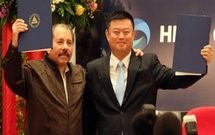 China's growing economic activity and diplomatic involvement in Central America show Beijing strengthening its ties with the region, despite the United States' historical dominance there. The current presence of the Chinese government and corporations is relatively small, and Chinese strategy in Central America does not immediately threaten U.S. economic and political power in those countries. In the long term, however, China intends to use steadily increasing trade and investment to obtain access to Central America's emerging markets and gain political allies.
China's growing economic activity and diplomatic involvement in Central America show Beijing strengthening its ties with the region, despite the United States' historical dominance there. The current presence of the Chinese government and corporations is relatively small, and Chinese strategy in Central America does not immediately threaten U.S. economic and political power in those countries. In the long term, however, China intends to use steadily increasing trade and investment to obtain access to Central America's emerging markets and gain political allies.
China's strategy in Latin America seeks to fulfill three principal interests: securing resources abroad to maintain domestic economic growth, encouraging nations to recognize China instead of Taiwan and opening new markets for Chinese goods. For example, these objectives define the Chinese relationship with Venezuela. China has invested billions of dollars in joint ventures for oil extraction and maintained political recognition from Venezuela, while its trade relations with that country have flourished.
Central America's relationship with China differs from this because of its relative resource scarcity and deeply rooted political and economic connections to the United States. This lack of energy or mineral resources has led Chinese firms and diplomats to focus more on bilateral trade and political recognition.
The favorable geographic characteristics of the narrow Central American isthmus separating the Pacific and Atlantic oceans also stoked interest from Chinese representatives, among others, in constructing an alternate transit route to the Panama Canal. A proposed canal in Nicaragua, which has been envisioned for more than a century, would connect Nicaragua's Caribbean and Pacific coasts. In June, the Nicaraguan legislature approved a $40 billion proposal by a Hong Kong-based company to construct it. The company's owner said construction would begin in 2014 and end in 2020. The planned canal would be 286 kilometers (178 miles) long and allow ships displacing 400,000 tons to pass. Private Chinese companies have also expressed interest in studying the feasibility of proposed railroads between the Caribbean and Pacific coasts of Honduras and Colombia as alternatives to shipping cargo through the Panama Canal.
Despite reports of China's involvement in significant infrastructure projects, recognition of China and expanded trade remain the dominant issues in its relationship with Central America. China increased its trade with the region and obtained political recognition from Costa Rica by providing states with public works and economic incentives. In 2007, for example, China incentivized Costa Rica to expel Taiwanese diplomats and recognize China by offering the country a $130 million aid package and purchasing $300 million in Costa Rican bonds. Central America's relative poverty and lack of infrastructure make recognition of China a lucrative decision for regional leaders seeking financial aid. China has also increased its economic presence in Central American states more than Taiwan has, with China's exports to all nations there outpacing those of Taiwan. Costa Rica remains the only regional country to date that recognizes China, but Honduras previously expressed interest in reversing its recognition of Taiwan.
The United States' historical control of the area remains a barrier to any significant inroads by the Chinese. Central America's proximity to the world's largest importing market and U.S. political and military interventions in the region have ensured U.S. dominance.
Central America's proximity to the strategically important Gulf of Mexico makes it critical for the United States to ensure that no foreign competitor dominates that region. Central America also has traditionally acted as a buffer between the United States and any threats. During the first half of the 20th century, the United States secured Central American countries against internal political instability by conducting frequent military interventions to end conflicts and install U.S.-allied governments. After World War II, both the United States and the Soviet Union vied for ideological and material influence in the region. The result of these American efforts was its uncontested dominance of Central America and sensitivity toward potential threats from the region.
This U.S. authority discourages significant Chinese involvement in Central America. Any Chinese investment in significant infrastructure works, such as the proposed Nicaragua canal, could raise long-term political concerns in Washington. The entrenched U.S. influence in Central American political and economic systems makes such ambitious Chinese interaction with those states unlikely. Central America remains a valuable zone for U.S. strategic interests, which means Chinese influence there will likely remain focused on economic issues and modest political gains.
Courtesy : Stratfor (www.stratfor.com)